Living in a Material World
A worksheet where students are asked to rank items on their necessity for living a happy life.
Amazing Grace is taken from the album, Scandal of Mercy, available now! Find it on iTunes: http://apple.co/1Lxt5s1 · Amazon: http://amzn.to/21ek9Ru · Google Play: http://bit.ly/1Lb1bHy · and CD Baby: http://bit.ly/1Q0m9aZ. Discover more music of mercy on http://mission85music.com.
Start a Fire is taken from the album, Scandal of Mercy, available now! Find it on iTunes: http://apple.co/1XLQywI · Amazon: http://amzn.to/1PYujke · Google Play: http://bit.ly/1Qxgt5x · and CD Baby: http://bit.ly/1T750Rf. Discover more music of mercy on http://mission85music.com.
Scandal of Love is taken from the album, Scandal of Mercy, available now! Find it on iTunes: http://apple.co/1SWQlbf · Amazon: http://amzn.to/1Ok31AB · Google Play: http://bit.ly/1T61tCK · and CD Baby: http://bit.ly/1Lcm05i. Discover more music of mercy on http://mission85music.com.
Holy Spirit is taken from the album, Scandal of Mercy, available now! Find it on iTunes: http://apple.co/1LxreDP · Amazon: http://amzn.to/1VsJd3S · Google Play: http://bit.ly/1mWH6JJ · and CD Baby: http://bit.ly/1LG5k0Z. Discover more music of mercy on http://mission85music.com.
Despite is taken from the album, Scandal of Mercy, available now! Find it on iTunes: http://apple.co/1SWQlbf · Amazon: http://amzn.to/1Ok31AB · Google Play: http://bit.ly/1KJgDLd · and CD Baby: http://bit.ly/1VEu1R9. Discover more music of mercy on http://mission85music.com.
Scandal of Mercy (Acoustic) is taken from the album, Scandal of Mercy, available now! Find it on iTunes: http://apple.co/1SSPEiI · Amazon: http://amzn.to/1oAiTK8 · Google Play: http://bit.ly/1oGlXFd · and CD Baby: http://bit.ly/1T75l6d. Discover more music of mercy on http://mission85music.com.
Searching is taken from the album, Scandal of Mercy, available now! Find it on iTunes: http://apple.co/21eDzsQ · Amazon: http://amzn.to/1QbgfBV · Google Play: http://bit.ly/1QeApOJ · and CD Baby: http://bit.ly/1R1xsO7. Discover more music of mercy on http://mission85music.com.
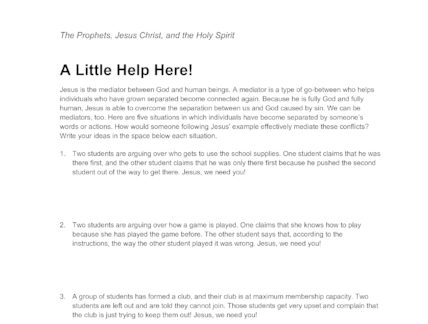
After reading several real-life examples of conflict, students provide suggestions to mediate each situation.
The song/video “Man in the Mirror,” by Michael Jackson, is available on YouTube in a variety of versions. This contemporary song encourages individuals to change the world by first changing the way they act themselves. It is appropriate for use …
The Crystalina Evert video "Crystalina’s Testimony (Part 1)—Love or Lust?" available on YouTube (12:20), is best used on day 2 or day 3.

A lesson plan for lesson 15 in The Catholic Faith Handbook for Youth: Catechist Guide.

This guided meditation communicates the Gospel message of simple living in a way that engages the imagination and inspires young people to actively simplify their lives. This activity is an excerpt from the book Justice and Service Ideas for Ministry …

This handout challenges students to decide how they would have reacted as a disciple after Jesus’ trial, death, and resurrection
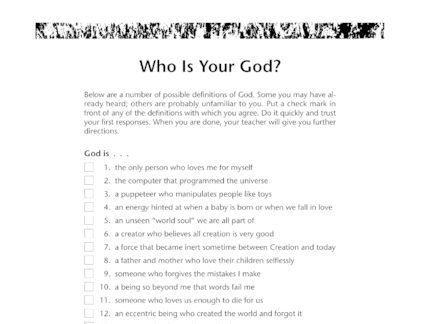
A reflective worksheet where students identify meaningful definitions of God

An individual worksheet where students rank the priority Jesus placed on certain values in his ministry

Small-group activity that guides students to discover the culture of Jesus’ world by searching the Gospels
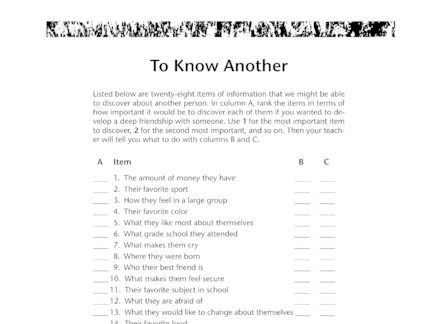
An individual worksheet where students rank the importance of discovering specific types of information about another person

This handout assigns students to a made-up Parish Council Committee. Students must then brainstorm ideas and activities to help engage young people in the life of the parish.

Students answer questions about the story of Jesus' Resurrection from one of the four Gospels.

Students review many familiar miracles performed by Jesus in the gospels before choosing a favorite.

This handout asks students to reflect and write about the ways that Jesus' healing is needed in their lives.
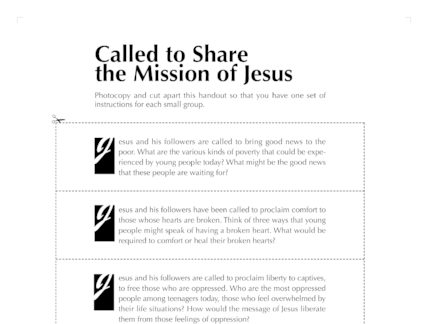
This small-group activity provides each group with an example of Christ's mission. Groups must answer questions surrounding their particular example.

Students read passages from the Gospels to explore the numerous emotions that Jesus experienced during his time on Earth.

This handout presents a list of different definitions and identities for God. Students are asked to choose ones that resonate with them.

This handout asks students to rank a list of items in life and society according to their importance.

This prayer service reflects on some of the aspects of relationships.

This handout helps students to explore the communication and relationship they have with their parents by asking a series of reflective questions for students to answer.

This handout helps teens reflect on their body image and the influences on their attitudes towards their bodies.

This handout presents numerous questions about healthy, life-long marriages for students to think about and answer.

This handout presents several real-life family situations about which students must evaluate and make a decision.

This handout provides several examples of parenting dilemmas. Students are to read the situations, choose a course of action, and explain their thoughts.

This handout gives a brief explanation for several types of relationships that end in marriage. Students are then asked to evaluate the reading and complete a journal prompt.
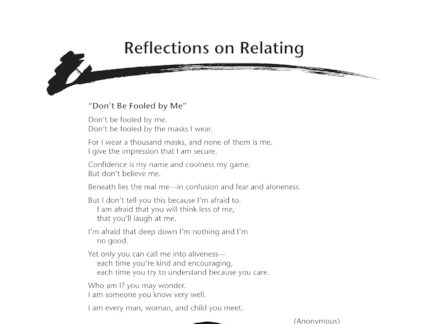
This poem provides a reflection on the fears and insecurities that we all carry underneath the outward impressions we give off.

This handout provides the scoring that should be used to interpret the accompanying Handout 9-D.

For this worksheet, students choose which behaviors match how they typically respond to conflict in relationships.

Students identify with whom in their life they would share a list of personal pieces of information.

Students reflect on and answer a series of questions about their listening skills.

Students reflect on and answer a series of questions about their interpersonal style and relationships with others.
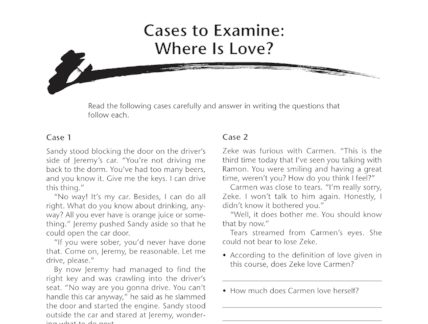
Students read and respond to several stories about what it means to love yourself and others.

This is a writing prompt to help students reflect on what it is like to be a virgin in society today.

This article gives information about common STDs and AIDS.

This handout provides a list of True/False statements about sexually transmitted diseases and AIDS.

This handout provides two role-play situations in which a couple has discovered they are pregnant.

Students share their opinions in response to a series of statements about gender roles in society.

Students share their opinions in response to a series of statements about gender roles in society.

Students identify the different associations with and meanings of sexuality as portrayed in the media, by peers, and from adults.

This handout presents a series of statements about sexuality. Students are to indicate their level of agreement or disagreement with each.

On this handout students calculate the fixed expenses of an independent adult on a monthly and yearly basis.

Students estimate the cost of a list of items needed to live independently. This exercise is meant to help students understand the amount of money needed to survive.

On this handout students explore the qualities they look for or want in a job and brainstorm possible jobs that fit those qualities.

Students rank a list of careers based on their importance and prestige in society.

This handout provides a list of statements designed to help students evaluate the leisureliness of a specific person.

This handout asks students to decide which types of leisure activities their peers encourage them to participate in.

Students categorize their favorite leisure activities based on the primary benefit they receive from each.

This handout presents two real-life scenarios for which students must read and answer questions.

Students list leisure activities in which they participate before rating the frequency and satisfaction for each.

This handout provides a diagram for students to fill in as they reflect on the impact of friendship and relationships.

Students rank eight possible goals of formal education based on their importance or relevance.

Students read several scenarios and rank the level of independence demonstrated.

Students choose adjectives from a list to describe a specific person.

This handout provides a series of questions for students to answer about themselves.

This handout asks students to rank statements according to their beliefs about what it means to be fully alive.

This handout provides three situations for students to read and evaluate. Students must give a suggestion for how to respond to the conflict in each scenario based on the strategies in the book.

This handout provides the beginning of a story about a teen who is about to break up with his girlfriend. Students are to complete the story following teacher instructions.

This handout provides three situations where teenagers are not fully respecting themselves. Students read the situations and respond with suggestions that demonstrate more self-respect.

This handout provides two role-play situations for students to practice open, honest communication in a kind, truthful way.

This handout provides a chart to help students keep track of the types of truths and lies portrayed on TV.

This handout provides a chart to help students keep track of their expenditures during one week

This handout provides several comments from teenagers about sex. It can be used as a discussion starter or writing prompt.

This handout provides three different comments from teens about their drug and alcohol usage. This can be used as a discussion starter.

Students read several real-life scenarios and explore the many fears, anxieties, and pressures that influence decisions.

This handout provides several statistics and pieces of information about the alarming needs of children in our world.
A short video that uses the three forms of water (solid, liquid, gas) to explain the trinity.
A brief explanation of tradition versus Tradition. A short video about how Catholic traditions that have been handed down help God reveal himself to us.
A personal reflection on how Jesus’ life, death, resurrection, and ascension save us from sin and death and bring us to new life in him.
A personal reflection on why Catholics ask the saints and Mary for prayers.
An easy-to-understand explanation of what Catholics believe about Heaven, Hell, and Purgatory.
A personal story about turning to Jesus for help and loving others unconditionally, just as Jesus loves us.
A personal story about living out the principles of Catholic Social Teaching.
A personal story about discovering how Catholicism is truly universal.
A wonderful analogy on how the Trinity is like an apple tree.

Students are asked to answer a series of “Dear Abby” style questions that deal with Internet safety.
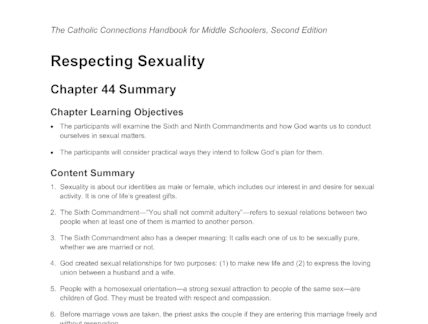
A nice summary of the Sixth and Ninth Commandments, and how God wants us to conduct ourselves in sexual matters.
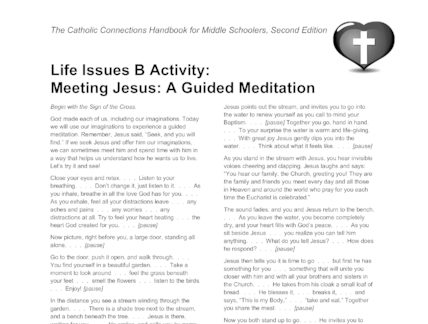
A guided meditation that uses the imagination to spend time with Jesus and understand how he wants us to live.

A nice summary of the ways God promises to be with us always.

A good summary on dealing with peer pressure.

A worksheet where students are asked to rank items on their necessity for living a happy life.
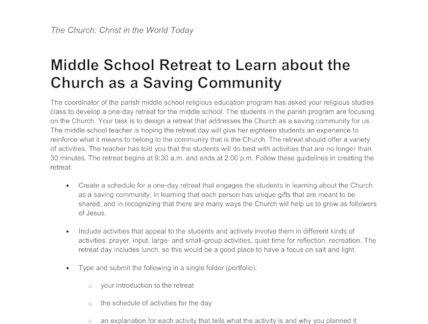
An outline to help plan a middle school retreat focused on the Church as a saving community.

A worksheet where students are asked to research a mission or volunteer organization and answer several questions about their findings.

An activity to help students understand the Lord's Prayer from "The Catholic Faith Handbook for Youth" Teacher Guide.

An activity to help students learn "The Lord's Prayer" from "The Catholic Faith Handbook for Youth" Teacher Guide.

A worksheet to help in preparing for a celebration of the Eucharist, from "The Catholic Faith Handbook for Youth" Teacher Guide.

Praying with Scripture, using The Magnificat, from "The Catholic Faith Handbook for Youth, Teacher Guide.

A guided meditation on praying with scripture from "The Catholic Faith Handbook for Youth" Teacher Guide.

A meditation on a goal or concern from "The Catholic Connections Handbook for Youth" Teacher Guide.
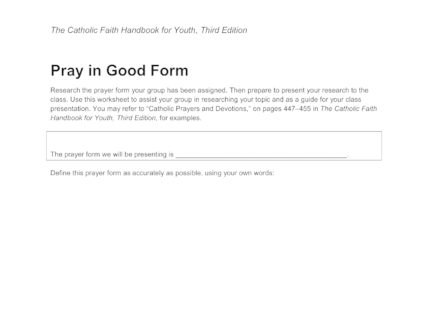
A worksheet, from "The Catholic Faith Handbook for Youth" Teacher Guide, to assist students in researching and presenting different prayer forms.

An introduction to prayer from "The Catholic Faith Handbook for Youth" Teacher Guide.

A worksheet, found in “The Catholic Faith Handbook for Youth” Teacher Guide, that is based on students’ current understanding and experience with prayer.

A vocabulary sheet from Unit 6 of "The Catholic Faith Handbook for Youth" Teacher Guide.

A rubric for final performance tasks for Unit 6 of "The Catholic Faith Handbook for Youth" Teacher Guide.
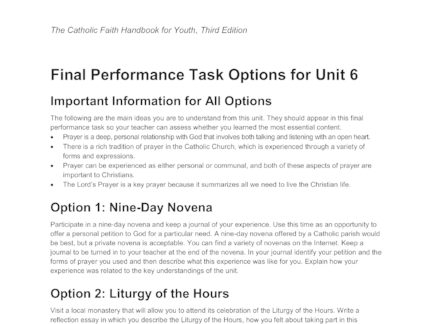
Options for final performance tasks for Unit 6 of "The Catholic Faith Handbook for Youth" Teacher Guide.

A handout on defining the Cardinal Virtues and describing how a person who exhibits the Cardinal Virtues acts.

A worksheet focused on what the Ten Commandments teach us about living in right relationship with God and with our neighbors.
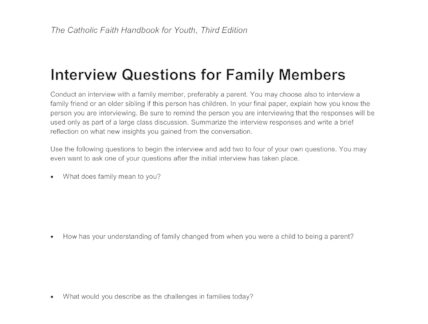
Several interview questions for family members on family life and the Fourth Commandment.

A worksheet on honoring God based on students’ knowledge of the first three Commandments.

Two scenarios that involve people making moral choices. Students are asked to identify the object, intention, and circumstances surrounding the act in the scenario and indicate whether the choice is morally good or morally bad.

A list of vocabulary terms and definitions for Unit 5 of The Catholic Faith Handbook for Youth, Third Edition.
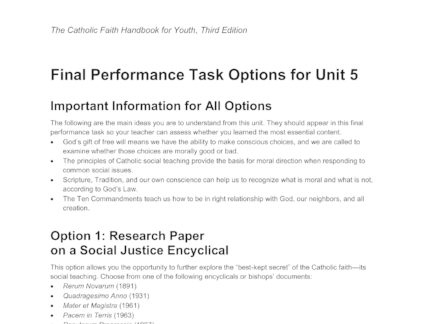
Several final performance task project options for Unit 5 of The Catholic Faith Handbook for Youth, Third Edition.
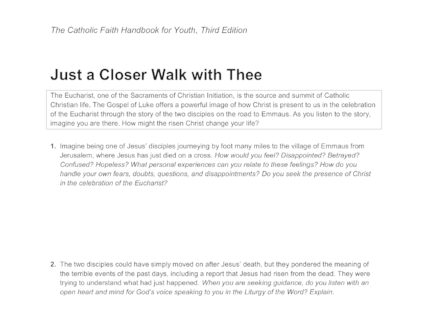
A worksheet where students are asked to read and reflect on the Gospel of Luke’s powerful image of how Christ is present in the celebration of the Eucharist through the story of the two disciples on the road to Emmaus.

A worksheet on symbols, their abstract meanings, and how they are integral parts of Church liturgies.

A worksheet where students are asked to fill in information on the liturgical calendar.

A worksheet that looks at the seven Sacraments.

A list of vocabulary terms and definitions from Unit 4 of The Catholic Faith Handbook for Youth, Third Edition.
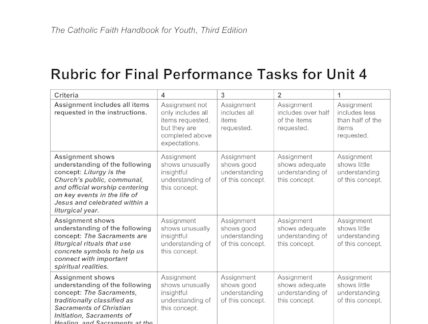
An evaluation rubric for the project ideas from Unit 4 of The Catholic Faith Handbook for Youth, Third Edition.
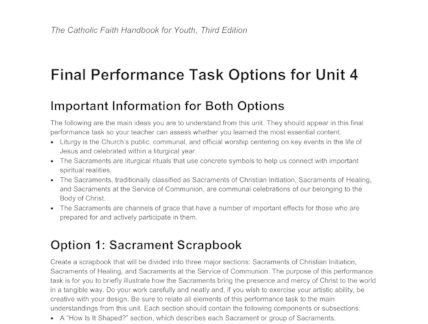
Several project ideas that coincide with Unit 4 of The Catholic Faith Handbook for Youth, Third Edition.

An activity where students are asked to research several religious traditions, complete a comparison chart, and then reflect on their findings.

A chart that students are asked to fill in with at least two examples of ways the Church models the four marks of the Church, and at least two examples of ways they model the four marks of the Church.
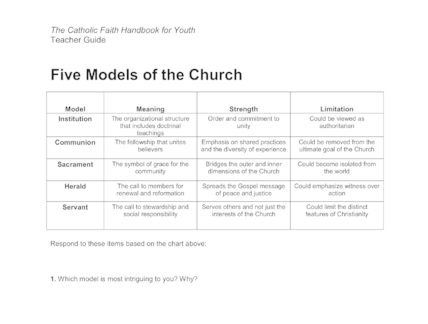
An activity where students are given a chart containing the meanings, strengths, and limitations of each of the five models of the Church and asked to answer related questions.

A survey that will help students consider how difficult it might be to walk in the shoes of another person who may be quite different from them.

Scripture passages that go along with the group assignment that uses parables to see the Kingdom of God.

A group assignment on using parables to see the Kingdom of God.

A worksheet on the goodness of creation, using Scripture passages from the Book of Genesis.

A worksheet on students’ understandings of the mission of Jesus Christ.
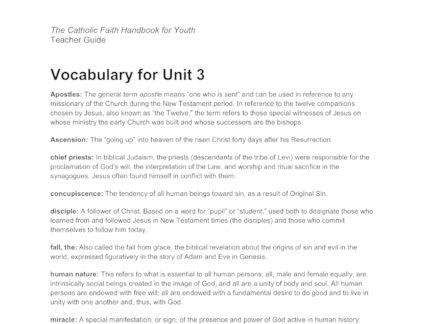
Vocabulary terms and definitions for Unit 3 of “The Catholic Faith Handbook for Youth.”
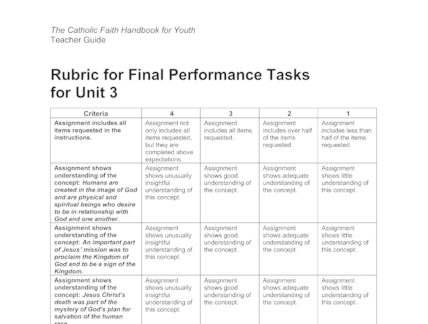
An evaluation rubric for the final performance task options for Unit 3 of “The Catholic Faith Handbook for Youth.”

Several final performance task options for Unit 3 of “The Catholic Faith Handbook for Youth.”

An activity on the best description of faith, based on students’ experiences and understanding.

An activity where students rate their level of agreement on statements about Jesus.
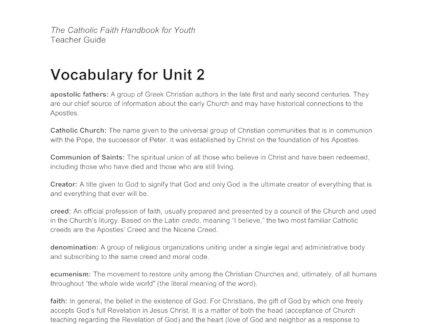
Vocabulary terms and definitions for Unit 2 of “The Catholic Faith Handbook for Youth.”
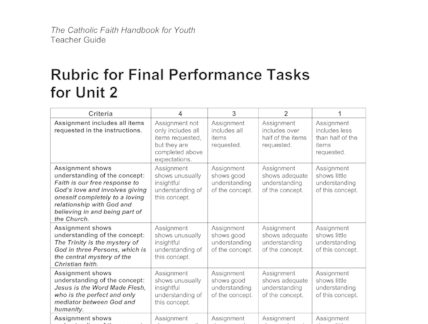
An evaluation rubric for the final performance task options for Unit 2 of “The Catholic Faith Handbook for Youth.”
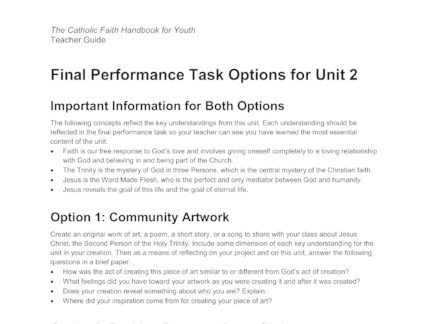
Several final performance task options for Unit 2 of “The Catholic Faith Handbook for Youth.”

A listing of Saint Thomas Aquinas’ five proofs for the existence of God.
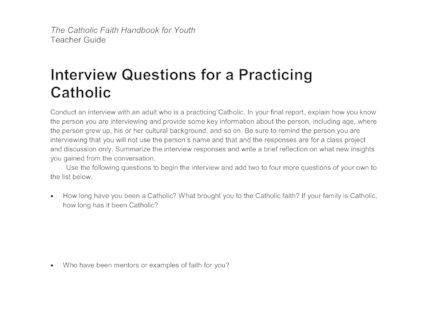
A list of interview questions to ask a practicing Catholic.

Vocabulary terms and definitions for Unit 1 of “The Catholic Faith Handbook for Youth.”

An assignment where students test their knowledge of Catholicism.
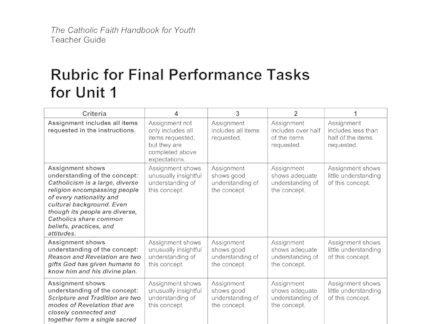
An evaluation rubric for the final performance task options for Unit 1 of “The Catholic Faith Handbook for Youth.”
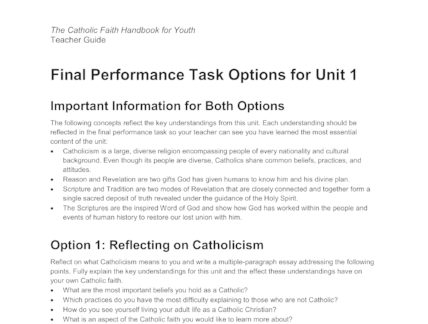
Several final performance task options for Unit 1 of “The Catholic Faith Handbook for Youth.”
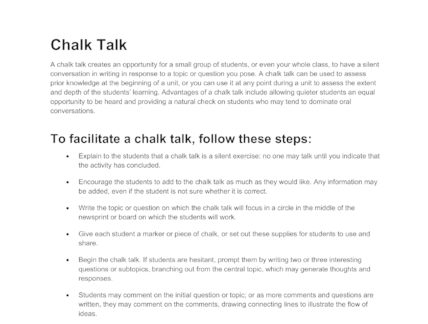
Steps on how to facilitate a silent conversation in writing in response to a topic or question posed.
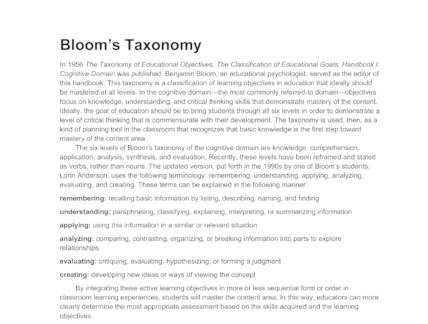
A short reading where the six levels of Bloom’s taxonomy of the cognitive domain are explained.

An article on how to use sustained silent reading as an effective tool in the classroom.

A worksheet where students work to fill in Abraham’s family tree, from “The Catholic Youth Bible” Old Testament Teacher Guide.

A worksheet that uses certain Scripture passages to describe covenants, from “The Catholic Youth Bible” Old Testament Teacher Guide.

An activity where students read certain Scripture passages and look for illustrations of community and identity, from “The Catholic Youth Bible” Old Testament Teacher Guide.

An activity where students read an assigned Scripture passage of the mythical genre and then work on interpreting what they have read, from “The Catholic Youth Bible” Old Testament Teacher Guide.
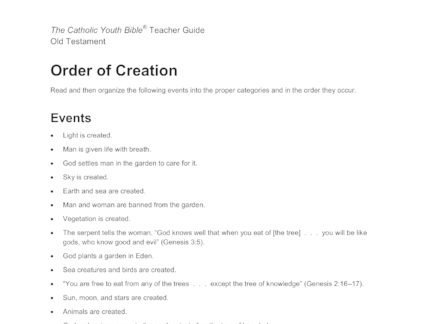
A worksheet where students are to organize several Creation events into the proper order in which they occurred. Students are to look at both of the Creation stories in the Book of Genesis.

An activity dealing with different perspectives of the same event, from “The Catholic Youth Bible” Old Testament Teacher Guide.

A sheet of vocabulary terms and definitions for Unit 2 of “The Catholic Youth Bible” Old Testament Teacher Guide.
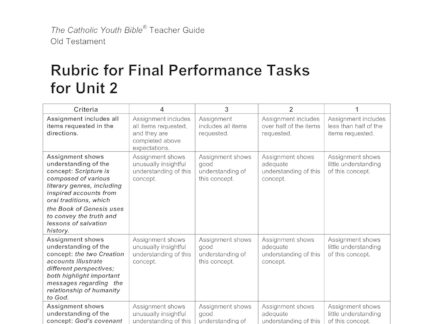
A grading rubric for the final performance task options for Unit 2 of “The Catholic Youth Bible” Old Testament Teacher Guide.
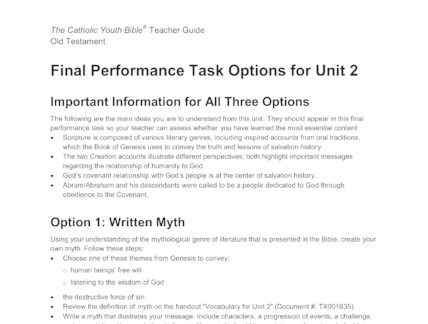
Several final performance task options for Unit 2 of “The Catholic Youth Bible” Old Testament Teacher Guide.

A sheet of vocabulary terms, and blank spaces for students to write in the definitions, from “The Catholic Youth Bible” Old Testament Teacher Guide.

A mind map for a brainstorming activity on the Bible, from “The Catholic Youth Bible” Old Testament Teacher Guide.

A review of students’ understanding of unit material and their learning experiences. This review consists of several questions and encourages additional written feedback from students.

A student observation form for the Socratic seminar debate method.

Socratic seminar symbol codes to help quickly evaluate a seminar speaker.

A reading on the process and expectations for the Socratic Seminar debate.

A reading on using rubrics to assess or evaluate students’ work.
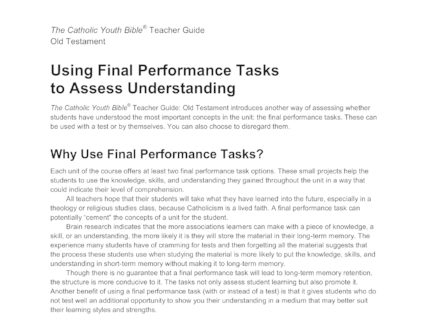
A reading on using final performance tasks in the classroom to assess students' understanding.

One-act plays give students the opportunity to be creative as they explore a concept, issue, dilemma, person, or situation.
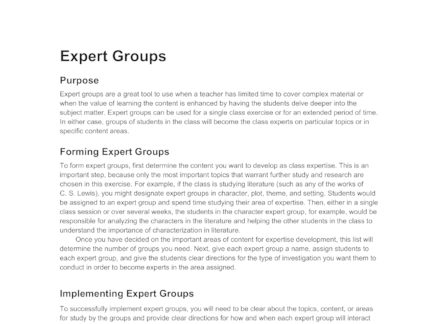
A reading on how expert groups are a valuable classroom instructional strategy that helps to build student confidence, class collaboration, and expertise in chosen topics.

A document on suicide prevention including warning signs, action steps, online resources, and lifesaving facts to consider.

A reading on how to use graphic organizers as learning tools to deepen understanding.

This document explains the educational benefits of an audit, instructions on how to assign an audit, and an example of an audit handout.

Instructions on how to effectively use Learning Stations in the classroom.
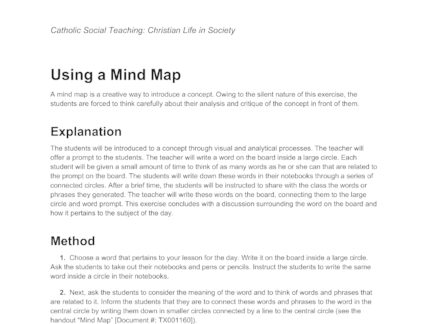
A reading on using a mind map, which is a creative way to introduce a concept.

A reading on a quick and participative assessment tool called the whip-around.
A brief description of the work and lives of the college-age volunteers of the Jesuit Volunteer Corps (JVC). JVC is an example of an organization putting the ideas of Catholic Social Justice into practice.
A short series using cartoons to depict the story of Jesus' death and resurrection.
A short series using cartoons to depict the story of Jesus' death and resurrection.
A short series using cartoons to depict the story of Jesus' death and resurrection.

Please note that this document is only available as a PDF.
This PowerPoint is part of the Living in Christ Series. Rather than a philosophical or theological discussion of the mystery of suffering, this resource asks students to meditate and think about Jesus' example of suffering for people he loves.
This PowerPoint is part of the Living in Christ Series. It uses vivid images to discuss the various signs and symbols that represent the Paschal Mystery. Students are asked to reflect on why a certain symbol is significant.